#Mount Agung
Explore tagged Tumblr posts
Text

A terrifying yet beautiful view of Mount Agung, an active volcano in Bali, Indonesia that erupted several times since 2017
#active volcano#mount agung#baliindonesia#bali#indonesia#beautiful asian nature#travel photography#amazing nature#travel#nature#travel destinations#landscape#landscape photography
787 notes
·
View notes
Text

Mount Agung by night - Judith Ansems , 2022.
Dutch, b. 1972 -
Oil on canvas , 120 x 160 cm.
219 notes
·
View notes
Text

Bruh.
29 notes
·
View notes
Text

Mount Agung, Sidemen, Bali, Indonesia
Geio Tischler
0 notes
Text

Tulamben Beach: A Diver's Paradise in Bali
Nestled on the northeastern coast of Bali, Tulamben Beach beckons underwater enthusiasts with its mesmerizing marine biodiversity and fascinating shipwreck dives. Encircled by lush landscapes and framed by the towering Mount Agung, this hidden gem offers a serene escape from the bustling tourist hubs. Immerse yourself in crystal-clear waters teeming with vibrant coral gardens and exotic sea creatures. Whether you're a novice or seasoned diver, Tulamben Beach promises unforgettable underwater adventures amidst stunning natural beauty.
#Tulamben Beach#Bali#diving paradise#marine biodiversity#shipwreck dives#Mount Agung#underwater adventures#coral gardens#sea creatures
1 note
·
View note
Text
youtube
#Agung#Campi flegrei supervolcano update#Krakatoa#Mount Bromo#Mount Rinjani#active volcano#active volcanoes#campi flegrei#campi flegrei 2023#eruption#italy volcanoes#mount vesuvius#naples supervolcano#natural disasters#super volcano#super vulcano#supervolcano eruption#supervulkan europe#volcanic activity#volcanic eruption#volcano erupts#volcano explosion#Napoli Will Disappear#Supervulcano Campi Flegrei about to Erupt#Youtube
1 note
·
View note
Text

Beautiful view of Mount Agung, an active volcano in Bali, Indonesia - Author: SeductiveFaith
215 notes
·
View notes
Text

Mount Agung eruption
photo: Oemocean.one
69 notes
·
View notes
Text
The Abatwa [Zulu mythology]

The Abatwa (singular: ‘Umutwa’) are a strange species of very tiny human-like creatures.
These peculiar beings make their homes in anthills, as they seem to have a mutualistic relationship of some sort with ants. Despite their diminutive stature, the Abatwa are ferocious hunters and are able to kill animals, which they consume entirely before moving on.
They are skilled archers and although their tiny arrows may be as small as a splinter, the Abatwa coat their arrowheads with an incredibly potent venom that can even kill humans. When a target is struck with one of these arrows, the strange poison causes immense bleeding, and the victim dies soon after. Because of this, the Zulu greatly feared the Abatwa.
Generally speaking, the Abatwa are incredibly self-conscious about their height and are even willing to kill humans for pointing out how tiny they are. Saying ‘I saw you!’ is a standard greeting among the Zulu, so people spotting an Umutwa would say ‘I saw you!’ out of politeness. Yet the Abatwa then immediately ask ‘when did you spot me?’

If you answer something along the lines of ‘just now’ then the Umutwa will kill you on the spot, because of the implication that they were too small to be seen from far away. Conversely, people who replied with something like ‘I saw you an hour ago, when I was standing on that mountaintop over there!’ live to tell the tale, as the Abatwa take this as a great compliment.
The Abatwa can travel on horseback to hunt, though they do so in a peculiar way. When these creatures mount a horse, they sit in single file behind each other, in one long row of riders stretching from the animal’s mane to its tail. It is said that if such a hunting party fails to find game, they will kill the horse instead.
Interestingly, in reality, ‘Abatwa’ is the name of a different tribe of people with whom the Zulus had made contact, and who are generally smaller than the Zulu people themselves. It is therefore not farfetched to think that the story of these tiny fairy people might actually have been derived from the first contact between these two cultures. Eventually, the story got retold enough times and twisted to the point of fiction.
Source: Callaway, H., 1868, Nursery tales, traditions, and histories of the Zulus, in their own words, with a translation into English, Volume I, Springvale, 410 pp., p.352-355.
(image source 1: Agung Wulandana, illustration for ‘Mythical Creatures of Africa, 2016’)
(image source 2: Stephen Player)
#African mythology#Zulu mythology#Mythical creatures#Humanoid creatures#Fairies#Mythology#Myths#Folklore#Tiny ant-riding archer people
66 notes
·
View notes
Text

Amongst the estimated 17,000 islands that make up the Indonesian archipelago, one shines brighter than them all. This island has been called many names: The Morning of the World, Island of Peace, Island of Love. The name that resonates the most however, is The Island of the Gods. Sandwiched between the fiery island of Java and a wild, rugged Lombok, Bali has lived through an incredibly diverse history; a history that has created the truly unique place it is today. But what exactly makes this island so distinct from the rest of Indonesia, and indeed, the world? And most importantly, why is Bali called the island of the Gods?
Balinese hinduism is unique, shaped by the island's animist past. Worshipping deities like Dewi Sri, goddess of rice and Dewi Danu goddess of the lake ensures the wellbeing of Bali's agricultural life. Nature and spirits are revered with Mont Agung considered the holiest of all.
In hindu Dharma the name for Balinese modern hinduism many ancient beliefs remain in rituals. Temples are aligned with Mount Agung. God or Sang Hyang Widhi Wasa manifests in various forms, such as Bhatara Segara at sea temples and Bhatara Dalem at village temples. This is why Bali si known as the Island of the Gods.
Even modern hinduism's Trimurti of Shiva, Vishnu and Brahma are considered manifestations of Sang Hyang Widhi Wasa. Where the god 'sits' on a shrine or pelinggih (meaning seat) they will manifest into the appropriate form, presented with offerings and prayers for a certain funtion.
Ancestors are equally as important to the Balines Hindu; they are often given as much attention as the gods if not more.
4 notes
·
View notes
Text
GUBAT BANWA: THE RAJANATE OF GATUSAN

WARRIORS. POETS. SPIRITUALISTS. The Hundred Island Rajanate—a league of allied polities all pledging to PONONG RAJA (Head King) BATARA AMBASI as their leader. Those that have settled in communities tremble when they near, their agung resounding and their war drums reverberating. SEIZE HEAVEN’S THUNDERCLAPS: GATUSAN!
The Gatusan Rajanate is inspired by Hindu-Buddhist Maritime Kingdoms of Southeast Asia (Srivijaya, Majapahit, Singhasari, Champa), as well as the ancient Pintados that still cling to life to this day.

This includes the raiding cultures of pre-colonial Sugbu (ruled by Raja Humabon), Bo-ol, Buglas, Opon, Samar, Leyte, Butuan, and much more. Clad in heavy bahag and cuirasses (sometimes elephant hide, other times shark skin, often hardwood), wielding aggressive kalasag and spears (bangkaw), kings wield grand kampilans and sail on sea-splitting warships (karakoa) and merchant ships to scour the seas!

They are a people of ritual and signs—an azure bird flying across their path in the wrong direction is a bad omen. Before going on raids, they perform divinations and offerings to their gods. Their kings, their rajas, exude charisma, filled with spiritual power, emblazoned with it through their tattoos, which signify their achievements are true. Many Kings are feared like gods—many kings have access to superior occult power.
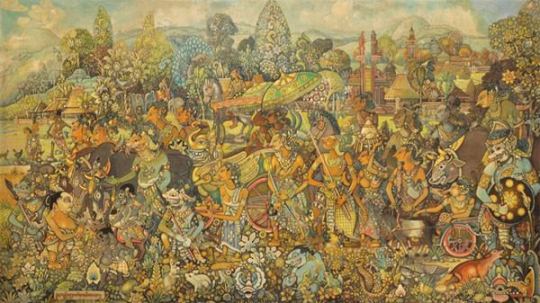
The greatest polity, the center of mandala power, Kangdaya, is pierced through with influences from outside the Sword Isles and from the far Sword Isles. They have palaces and grand stupas, they have a thousand buddhas and gods that they worship, localized from foreign merchants.
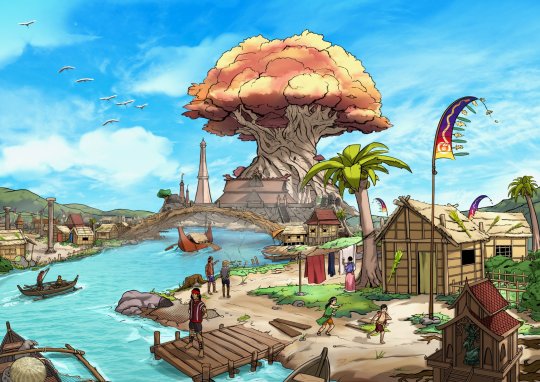
They worship Jamiyun Kulisa the great Sky God, and Rajaraya Pintas the Ancestor, though they have an extensive pantheon of their own, with gods so numerous it would be sacrilegious to name them all in a list.

Their religion is skewered with ritual—they mummify and fumigate their dead in an act of worship, they perform long rituals to accrue merit and fortune so that their days are better, praying to both gods and saints—they’re the same in power and intercession, after all.
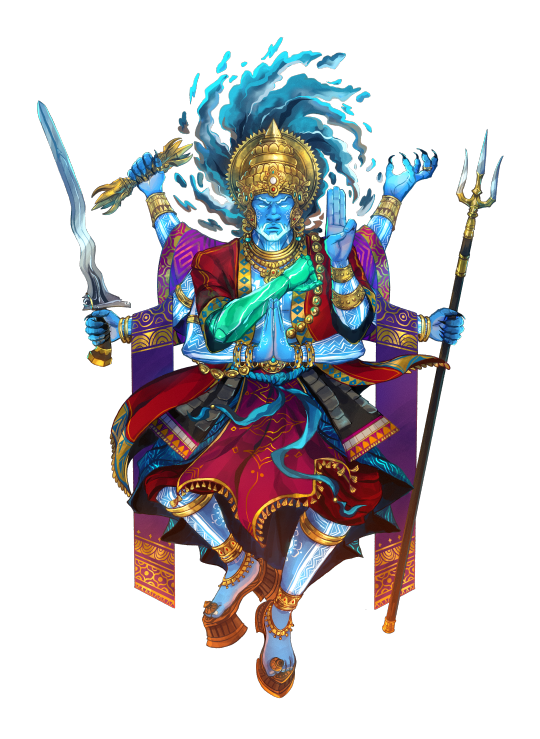
Gatusan Disciplines tend to be focused on dealing damage and opening up enemies. To that end, here are the five martial Disciplines you can learn and take on as Kadungganan in the Core Rulebook!
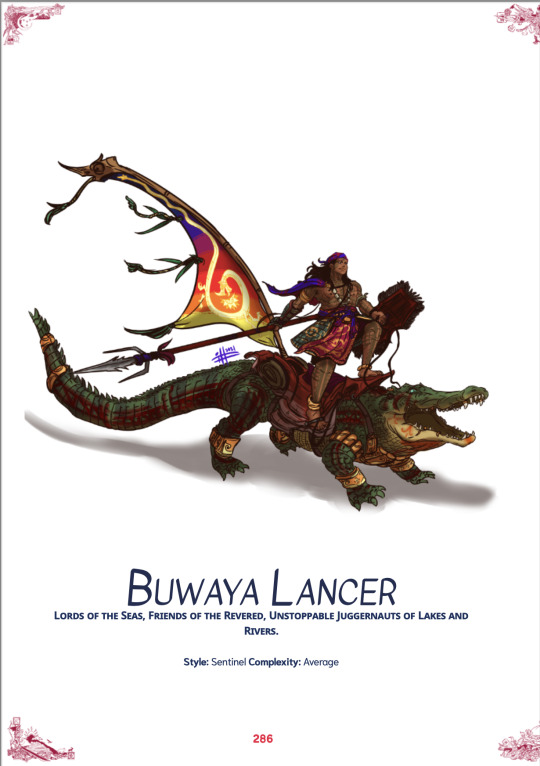
BUWAYA LANCER. The grand sentinels of the ancestor god, who have the ability to evolve their crocodile mounts into grand makara! Mechanically they are focused on creating a “Lair”—everything adjacent to them cannot escape. Their techniques let you carry another across the battlefield, activate an opportunity attack stance, perform a violent death roll, and destroy the land around you.
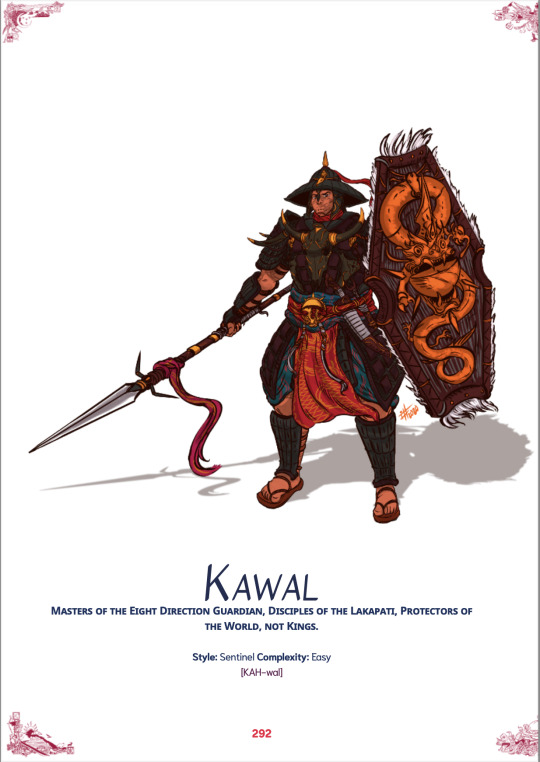
KAWAL. The quintessential sentinel. They have the ability to rush after an ally that moves while adjacent to them, and they get access to an opportunity attack. Both Buwaya Lancers and Kawal get to Opportunity Attack, exemplifying the raiding Violence of Gatusan. Their Techniques focus on building Block, generating Taunt, taking on vigilant stances, and destroying things with great hammers.

MANGANGAYAW. The quintessential raider that wants to attack, attack attack. They are stance dancers and can take on a powerful Stance that augments their attacks, and can ignore Combo Breaker when flanking a fighter. Their techniques let them unleash multiple attacks, counter attack, increase their damage, and store Hits.

SWORD POET. Tricky sentinels that intermingle sword and song together to confuse enemies and taunt them with hilarious sung poetry. Their Techniques involve them singing grand war songs: healing allies, confusing and debilitating enemies, and even give up a beat to manipulate the Rhythm!
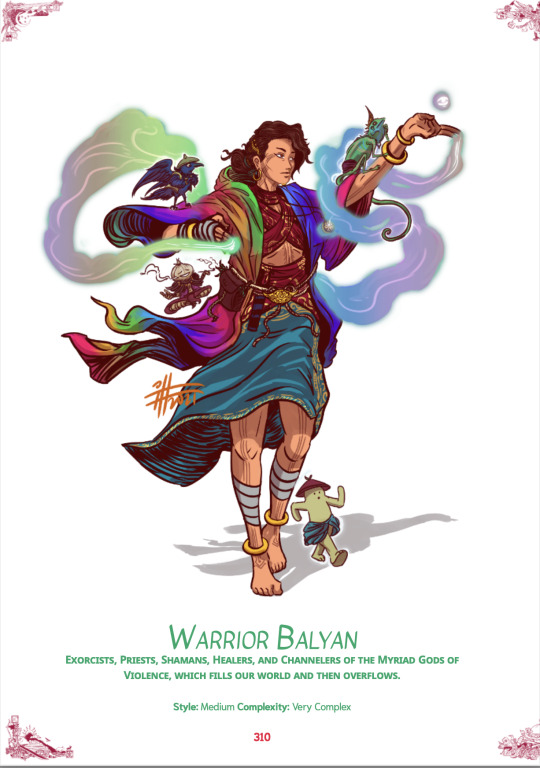
WARRIOR BALYAN. Quintessential Mediums who dance with stances (reflecting their trance state when possessed by the gods) as well as channel gods into the battlefield, letting them possess allies so they may partake in xenoglossy. Their techniques let them purify allies, augment their allies’ attacks, change the weather, and channeling the star goddess of dawn.
That’s just a small bite of what we have in store for you! Back us now and help us reach our full potential!
kickstarter
55 notes
·
View notes
Text
Mount Agung at dawn, Indonesia 🤔
#pay attention#educate yourselves#educate yourself#knowledge is power#reeducate yourselves#reeducate yourself#think about it#think for yourselves#think for yourself#do your homework#do your research#do some research#ask yourself questions#question everything#indonesia#travel#earth#the beauty of nature#beautiful earth
16 notes
·
View notes
Text
Rise of Bali island
Bali,Indonesia
Rise of Bali Island
listen to flashbacks from the island of Bali. Bali is a small fragment of the island of Java, which before being separated was the eastern tip of the island of Java.
In the 8th century, one of the holy Hindu priests came to Panjang Island, namely Bali at that time, bringing revelations he had received in his meditation on Mount Raung, East Java. namely to establish a new settlement at the tip of the island of Java.
The separation of the islands of Bali and Java is just like a canal
with around 600 followers began to visit the island of Bali and established settlements in Bali. In the place where he first came and established a settlement at that time.
Taro village can be seen traces of its history in the form of a temple that was founded in accordance with the temple where he received this revelation, called the Gunung Raung Temple. However, he and his followers could not survive long in Taro.
At that time, many of his followers died from nature and wild animals, including disease outbreaks, until his followers decreased drastically.
Because of the special power on this island. He returned to Mount Raung to avoid more casualties. then he meditated to get further guidance in establishing a new settlement in a place with this special power.
He also received instructions, namely that he had to plant the 5 elements in the highest place in the area, because this area contains very strong energy which must be neutralized with these 5 elements. He left after receiving the instructions by only inviting 200 of his followers to avoid more victims if something dangerous happened.He returned to his original camp and from here he opened the road to Mount Agung, the highest mountain. The holy data collector was named: Rsi Markandya, one of the Rsi from India who lived in East Java.
He and his followers succeeded in reaching this mountain and planting these 5 elements. and established settlements around this area. Since these 5 elements were planted, the Balinese population began to be created. Click here to include culture in your tour itineraries or travel plan
The priest also told his followers to make offerings to neutralize the power in Bali. Since then, Balinese culture has begun to emerge, where his followers use East Javanese culture with language and so on, but this language has developed so that it has a slightly different language structure.
The island they lived on because it prioritized offerings to neutralize the terrible power within it, this island has since been called Bali from the word WALI...
Many of his followers developed in the Bali area at that time. After the islands of Bali and Java were separated, many Javanese people came to Bali so many clans came. Many residents who first came to Bali are now called ancient traditional Balinese villages.
www.balisuthatourservice.top
#traveler#travel#travel abroad#travel channel#travel club#travel company#travel convenience#traveladdict#travelawesome#trip#culture#history#heritage#nature#mountains#landscape#nature photography#archaeology#anthropology#early modern history
3 notes
·
View notes
Text
Island Paradise: The Serene Beauty of Bali, Indonesia
Bali, the "Island of the Gods," is a true paradise on Earth. With its stunning landscapes, vibrant culture, and warm hospitality, it has captured the hearts of travellers from around the globe. Nestled in the Indonesian archipelago, Bali offers a serene and enchanting experience that is unlike any other. From pristine beaches and lush rice terraces to ancient temples and vibrant markets, this tropical haven has something for everyone. Join us on a journey as we explore the serene beauty of Bali, immersing ourselves in its natural wonders, cultural treasures, and soul-soothing experiences.
Enchanting Beaches and Crystal-clear Waters
Bali is renowned for its breathtaking beaches that stretch along its coastline. From popular destinations like Kuta and Seminyak to hidden gems like Nusa Dua and Sanur, each beach offers its own unique charm. Picture-perfect white sands, swaying palm trees, and azure waters create a postcard-worthy scene. Whether you're looking to relax under the sun, surf the waves, or indulge in exhilarating water sports like snorkelling and diving, Bali's beaches cater to every preference. A visit to the stunning beaches of Bali is a must for any traveller seeking tranquillity and natural beauty.
Ubud: The Cultural Heart of Bali
Located amidst lush greenery and terraced rice fields, Ubud is the cultural heart of Bali. This charming town is a haven for art enthusiasts, yoga practitioners, and seekers of spiritual enlightenment. Explore the vibrant local markets where you'll find unique handicrafts, textiles, and traditional artworks. Visit the magnificent Ubud Palace and witness captivating Balinese dance performances. Immerse yourself in the tranquillity of the Ubud Monkey Forest, where cheeky macaques roam freely amidst ancient temples. For a transformative experience, participate in a yoga or meditation retreat that will rejuvenate your mind, body, and soul. Ubud is a place where creativity, spirituality, and natural beauty converge.
Temples: A Glimpse into Balinese Spirituality
Bali is known for its countless temples, each with its own story and significance. The island's spiritual essence is deeply rooted in Hinduism, and the temples provide a glimpse into Balinese religious and cultural practices. The iconic Tanah Lot temple, perched on a rock formation by the sea, is a sight to behold, especially during sunset. Uluwatu Temple, located on a cliff with stunning ocean views, is not only a place of worship but also a venue for mesmerising Kecak dance performances. Besakih Temple, known as the "Mother Temple," is the largest and most important Hindu temple in Bali, set against the backdrop of Mount Agung. Exploring these sacred sites allows travellers to appreciate the deep spirituality and devotion of the Balinese people.
Rice Terraces: The Green Tapestry of Bali
The iconic rice terraces of Bali are a testament to the island's agricultural heritage. The intricate system of rice cultivation, known as subak, has been practised for centuries and is recognized as a UNESCO World Heritage site. The emerald-green rice fields, with their cascading tiers, create a stunning visual spectacle. Tegalalang and Jatiluwih are two of the most famous rice terrace destinations in Bali. Take a leisurely stroll through the terraces, breathe in the fresh air, and witness the farmers at work. The rice terraces not only offer a breathtaking landscape but also provide insight into the sustainable farming practices that sustain the island's economy.
Balinese Cuisine: A Gastronomic Journey
No visit to Bali is complete without indulging in its delectable cuisine. Balinese food is a flavorful blend of spices, fresh ingredients, and cultural influences. Sample the famous Babi Guling (suckling pig), Satay, and Nasi Goreng (fried rice) at local warungs (small eateries). Immerse yourself in the unique dining experience of a traditional Balinese feast, known as a "megibung," where a variety of dishes are served on a banana leaf. Don't forget to try the refreshing and healthy Balinese specialty, Jajan Pasar (market snacks), which includes colourful and sweet treats. Bali also boasts a thriving café culture, with quaint coffee shops serving artisanal coffee and innovative dishes. Embark on a gastronomic journey that will tantalise your taste buds and leave you craving for more.
Conclusion
Bali, Indonesia's Island Paradise, offers a serene and awe-inspiring experience that captivates travellers. From its enchanting beaches and spiritual temples to its cultural hub in Ubud and breathtaking rice terraces, Bali showcases the beauty of nature, the richness of its heritage, and the warmth of its people. Whether you seek relaxation, adventure, or a spiritual retreat, Bali has it all. The island's allure lies not only in its physical beauty but also in the spiritual essence that permeates every corner. A visit to Bali is a journey of self-discovery and connection with nature and culture. So pack your bags, immerse yourself in the serene beauty of Bali, and let this island paradise weave its magic on your soul.
3 notes
·
View notes
Text

Magnificent sunset scenery up from Melase Hill. The beauty of Mount Agung perfectly went bold over the hues of orange sky. Nature never fails to mesmerize and remind us of its breathtaking beauty 💚
2 notes
·
View notes



